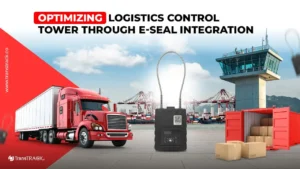Delivery Optimization in Logistics with Big Data Technology with TransTRACK
Posted on September 18, 2024 by Nur Wachda Mihmidati

Today, an efficient supply chain requires access to real-time information, in-depth analysis, and the ability to make decisions quickly. However, according to Gartner, only 7% of supply chains are capable of this today. This is where the role of Big Data in logistics becomes very important. Big Data enables automation at every stage of the supply chain, from information gathering, to analysis, to decision execution, significantly improving performance across the value chain.
With the use of Big Data, order fulfillment specialists can improve their operational efficiency. In addition, businesses can also provide faster and more transparent delivery at a lower cost. The end result is that customers will feel more satisfied as they receive timely and reliable services.
How is Logistics Using Big Data?
There is a notable trend in the logistics industry where the majority of shippers are increasingly investing in technology to optimize their operations. A total of 72% of shippers acquired Transportation Management Systems (TMS), Warehouse Management Systems (WMS), or other logistics applications, a significant increase over the previous year. On the other hand, 69% of them switched to Third-Party Logistics (3PL) solutions.
This investment shows that the logistics industry is increasingly recognizing the importance of technology to improve efficiency, reduce costs, and provide better service. One of the key elements of such technology is Big Data. With TMS, WMS, and 3PLs equipped with data-driven analytics capabilities, shippers can access huge and varied operational information, from shipping patterns to warehouse inventory.
Impact of Big Data in Logistics
The main objective of big data analytics is to maintain operational standards and improve efficiency in business processes. By utilizing operational data transparency and specific analytics, companies can reduce costs, maintain value, improve services, and avoid waste and risk.
Stock and Storage Control
Thoroughly recording and monitoring inventory information means companies always know where to find the needed supplies in the warehouse at any time. <Analyzing inventory data from systems and sensors helps determine when stock is running low or whether pallet racks are empty. With this analysis, companies can make more accurate inventory projections, predicting order and delivery patterns during peak and off-peak seasons, thus avoiding unnecessary stock shortages.
Route Optimization
Route optimization is not just about finding the shortest way from point A to B. Vehicle information, product information, GPS data, weather conditions, and driver shift schedules are all analyzed to find the best route. Big data takes all these factors into account to choose the optimal route. In some cases, the fastest route is not the best, as safety factors or the shock-sensitive condition of the goods also need to be considered. With vibration sensors and fuel monitoring, this analysis not only improves shipment safety but also helps optimize routes based on environmental impact.
Capacity Planning
Vehicle capacity, storage space, and labor are important factors in handling logistics. With big data analytics, companies can compare the usage and availability of all these capacity factors for each step of the logistics process. This analysis facilitates capacity forecasting by matching machine and vehicle capacity to spikes in demand or personnel needs. With proper planning, costly overcapacity and undercapacity that degrade service performance can be avoided, maintaining customer satisfaction.
Last-mile delivery optimization
Last-mile delivery optimization can reduce major costs in logistics, which account for 53% of total shipping costs. Challenges such as cooperation with service providers (42%), manual processes (41%), and fuel costs (32%) can be solved with big data. With the analysis of real-time delivery information, routes can be optimized, driver efficiency improved, and response to disruptions faster, thereby increasing efficiency and reducing overall costs.
Risk Management
Risk management benefits from better forecasting. By analyzing patterns from recurring events in a given process, big data makes the identification of risk factors more transparent. Factors that frequently cause disruptions in the supply chain are identified, so companies can take steps to address them before they occur.
Customer Satisfaction
A better understanding of customer preferences can strengthen customer loyalty. <Big data helps process unstructured information from various information channels regarding customer preferences. With these insights, companies can optimize customer service. Big data provides a comprehensive picture of customer needs, ultimately improving service quality and customer satisfaction.
Big Data Solutions in Logistics from TransTRACK for Supply Chain Optimization
TransTRACK delivers robust logistics solutions with Big Data integration, designed to improve efficiency, accuracy, and transparency in supply chain management. Here are some of its top features related to Big Data storage and utilization:
Centralized and Structured Data Storage
TransTRACK provides a centralized and structured data storage system, allowing logistics companies to efficiently manage information from various sources. Every piece of information generated by vehicle sensors, warehouses, and shipping transactions is collected in one platform for easy monitoring and further analysis.
Large-scale Data Processing
With Big Data support, TransTRACK is able to process large volumes of information from every point of the supply chain. This helps speed up decision-making, ensuring accurate information is available in real-time for shipment planning and inventory management.
Predictive Analytics for Delivery Optimization
The predictive analytics feature utilizes historical and real-time data to forecast trends and potential problems. With this technology, TransTRACK can predict demand, minimize delivery delays, and improve fleet utilization efficiency.
Real-time Tracking and Visibility
The integration of real-time tracking with IoT sensors enables full visibility into the movement of goods, delivery status, and fleet condition. With this information, companies can identify potential disruptions and immediately take proactive steps to mitigate risks.
Data-driven Route Optimization
TransTRACK’s route optimization feature uses real-time geographic and traffic information to determine the best path for delivery fleets. This not only speeds up delivery times, but also saves fuel costs and reduces carbon emissions.
Integrated Inventory Management
TransTRACK provides inventory management features that are linked to Big Data systems to ensure optimal availability of goods. This information enables automatic stock calculations, reduces the risk of stock-outs or overstocks, and improves demand accuracy.
Advanced Data Security
With secure Big Data storage, TransTRACK implements advanced encryption and strict security protocols to protect sensitive company and customer information. This ensures that all stored and processed data is protected from unauthorized access and cyber attacks.
Data-driven Fleet Condition Monitoring
TransTRACK allows companies to better monitor fleet conditions using information collected from sensors in the vehicles. This includes monitoring fuel, engine condition, and driver behavior, so preventive maintenance can be scheduled more efficiently.
Supply Chain Openness and Transparency
Big Data helps TransTRACK create transparency in every aspect of supply chain management, allowing logistics companies to share information with partners, customers, and third parties in the logistics ecosystem in a transparent manner.
Multi-System Integration for Better Collaboration
TransTRACK solutions can be integrated with other systems already used by companies, such as FMS (Fleet Management System), WMS (Warehouse Management System), and TMS (Transport Management System). This enables seamless information flow and better cross-functional collaboration.
With these features, TransTRACK helps logistics companies harness the power of Big Data for automation, efficiency, and faster decision-making in their supply chain.
Topic :
Recommended Articles

 Bahasa Indonesia
Bahasa Indonesia








